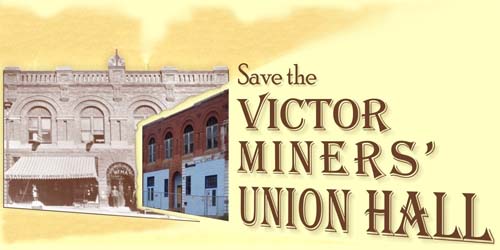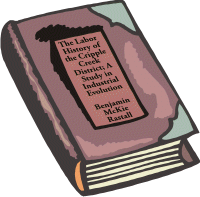 |
Victor
|
The Labor History of the Cripple Creek District;
A Study in Industrial Evolution
by Benjamin McKie Rastall

pages 59-64
PART II
THE STRIKE OF 1903-1904
CHAPTER I
THE INTERVENING PERIOD
The history of the Cripple Creek District from 1894 to 1903 is one of steady, healthy growth. There were periods of inflation, and of characteristic boom excitement, followed by the usual periods of depression. The values of the mining stocks fluctuated violently from a number of causes, and the failures of mining brokers were frequent. There was the constant question as to the permanence of the ore deposits, and the prophesy of the pessimists that Cripple Creek would prove merely a surface camp. But through it all the district grew in wealth and population; the mines increased their output; and general prosperity was the portion of those who lived within the mining area. The district in these years lost many of its frontier characteristics, and took upon itself the features of the modern productive center.
The increase in the number of mines and prospects was phenomenal. Every hill for miles came to be lined with roads, dotted with dumps and shaft houses, and thickly sprinkled with prospect holes. The vast majority of these small mines and prospects were finally deserted, but an occasional one became a paying property, and this was sufficient to keep a number of men constantly engaged in developmental work. The successful mines were equipped with the best modern mining machinery, and with various devices for the quick extraction and handling of ore. Shafts were sunk to a depth of nearly 1,500 feet, and some single mines developed miles of tunnelings.1
Three lines of railroad now connect the cities and principal towns of the district with the outside world, and their branches running to the various mines form a close network over miles of territory.2 So complete in fact are these connections that it is often possible to count a dozen lines of track upon a single hillside. Local trains run over the roads at short intervals, and two electric lines give frequent service to all points in the mining area. It would be difficult to find an industrial section with a more thorough or complete system of transportation connections.
Numerous small towns have sprung up throughout the district, and the general population has increased to about 50,000. The cities of Cripple Creek and Victor have both had a considerable growth, the former having a present population of about 12,000, and the latter 7,000. The business sections of both cities were razed to the ground by destructive fires in 1896 and 1899. The hastily constructed buildings of the early boom days were thus destroyed, and in their places have risen substantial modern structures of brick and stone.
In other respects the two cities have kept much of their frontier appearance. There is scarce a level piece of ground in the country, and except in the central portions of the towns, the houses straggle over the hills with hardly a semblance of order. The buildings are for the most part small, without porches or decorations, and weathered to an appearance often almost of unkemptness. Not a tree nor a lawn is to be found.3 Of parks there are none. The casual visitor catching his first glimpse as his train swings round the mountain-side, is likely to receive a distinct shock, and to carry away later an impression of roughness, uncouthness, and lack of the finer activities. But the cost of building material from the long shipment across the mountains explains the small size of the houses; the arid climate and hot sun takes almost instantaneous action on paint; and the soil and altitude make trees and lawns an impossibility. The rough appearance of the district is not an index of the character of its people. Within the unprepossessing exterior are homes of splendid taste, fine in their furnishings, conveniences, and life. Men of education and refinement have come to the Cripple Creek District, and their influence is seen in city water works, electric lights, good schools, hospitals, libraries, and churches. The district has kept much of its frontier aspect but lost much of its frontier character.
The rough externals cannot however but have a considerable selective effect. The lover of the easy, sheltered life will not gravitate to such conditions. It is the man to whom rough surroundings are agreeable or of secondary importance who will be attracted, and this means in many respects frontiersmen— the rough, hardy, fearless, independent, restraint-hating type of manhood. Thus the anomaly in a very recent frontier district, of a highly developed industrial center, which has kept most of its frontier aspects, and much of its frontier life.
The existence of the Cripple Creek District depends almost entirely upon its mining industry, and its prosperity rests upon the same source.4 No agriculture is possible, and scarcely any grazing; the district depends entirely upon outside shipments for its food supply. The same is true of manufacturing; none of the conditions for successful manufacture exist. All kinds of products, including building material, have to be shipped in, and the ores are shipped out of the district almost entirely for treatment. Business is local in its nature, arising from the economic needs of the district, and limited to the effective demand for consumption within the district. We have to consider then, not a strike of the ordinary type, involving merely a small class, and disturbing economic conditions only generally, but one that throttled the whole basic industry, and disrupted the entire industrial and business life of the section in which it occurred. Here lies the explanation for much of the intensity and fierceness of the struggle, for the alignment of forces, and for the bitter class strife that dominated it.
The working force remained almost entirely American. The unwritten law of the metal mining camps of the West, which does not allow Italian laborers, was in force here. The high rate of wages permitted the employment of a higher class of labor than is usual in mining, and the boast was constantly reiterated that Cripple Creek had the best set of miners in the world.5 The conditions of labor were also of the best. The mines were comparatively dry and well ventilated, the hours short, and machines provided to facilitate all operations. Good car service, and the modern improvements of the towns, added more than the comfort usual to the home life of a mining area.6
1The Portland Mine has 3 shafts and 25 miles of tunnelings.
The Independence has a 1400 foot shaft.
2The Florence and Cripple Creek Railroad. (Narrow Guage.) The Midland Terminal Railway. The Colorado Springs and Cripple Creek District Railway.
3This statement is not absolutely truthful. Two or three irrepressible citizens have succeeded with infinite care and attention in growing lawns of a few square feet, and a very few quaking aspen trees have been nursed into some show of thriving, but these facts only emphasize the general barrenness.
4The mines of the district have produced gold values as follows:
| 1891 | $200,000 |
| 1892 | 587,310 |
| 1893 | 2,010,400 |
| 1894 | 3,250,000 |
| 1895 | 6,100,000 |
| 1896 | 8,750,000 |
| 1897 | 12,000,000 |
| 1898 | 16,000,000 |
| 1899 | 21,000,000 |
| 1900 | 22,500,000 |
| 1901 | 24,986,990 |
| 1902 | 24,508,311 |
| 1903 | 17,630,107 |
| 1904 | 21,414,080 |
| 1905 | 22,307,952 |
| Total production to: | |
| 1906 | $203,245,150 |
The recorded dividends for 1905 were $4,032,740. The profits by lessees and close corporations for the same period are estimated at $1,000,000, making the net profits from the mining industry for 1905, about $5,000,000.
5The wage scale for an eight-hour day in force after 1894 was as follows:
| Per Day | |
| Trammers, single-hand miners, firemen and ordinary laborers | $3.00 |
| Timbermen, machine helpers, etc | 3.50 |
| Machine men | 4.00 |
| Engineers, foremen and shift bosses, $4.00 to... | 5.00 |
Graduates of many of the foremost universities of the country are to be found among the mine workers, and every year a number of the Colorado undergraduate students spend their summers in the Cripple Creek mines.
6The unions of the Western Federation of Miners in the district in 1903 were as follows:
Free Coinage Miners Union No. 19, Altman.
Anaconda Miners Union No. 21.
Victor Miners Union No. 32.
Cripple Creek Miners Union No. 40.
Independence Engineers Union No. 75.
Excelsior Engineers Union No. 80, Victor.
Cripple Creek Engineers Union No. 82.
Banner Mill & Smeltermens Union No. 106, Victor.
Special cars are run on the roads at the time the mine shifts change to take the men to and from their work. This enables the men to Jive in town while working at considerable distances in the outskirts of the district, and has had a considerable influence in centering so much of the life in Victor and Cripple Creek.
NEXT: Divisioning of El Paso county — Growth of unions in political power — Western Federation becomes socialistic